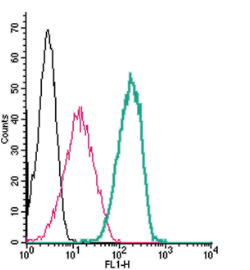Overview
- Peptide (C)RKNASNMEYRINKPRAE, corresponding to amino acid residues 194-210 of rat NPTN (Accession P97546). Extracellular, N-terminus.

 Western blot analysis of rat brain lysate (lanes 1 and 4), rat cerebellum lysate (lanes 2 and 5) and mouse brain membrane (lanes 3 and 6):1-3. Anti-Neuroplastin (extracellular) Antibody (#ANR-090), (1:400).
Western blot analysis of rat brain lysate (lanes 1 and 4), rat cerebellum lysate (lanes 2 and 5) and mouse brain membrane (lanes 3 and 6):1-3. Anti-Neuroplastin (extracellular) Antibody (#ANR-090), (1:400).
4-6. Anti-Neuroplastin (extracellular) Antibody, preincubated with Neuroplastin (extracellular) Blocking Peptide (#BLP-NR090).
 Expression of Neuroplastin in rat hippocampus and rat cortexImmunohistochemical staining of free floating frozen section of rat hippocampal CA1 region (A) and posterior cingulate cortex (B) using Anti-Neuroplastin (extracellular) Antibody (#ANR-090), (1:120). A. NPTN staining (green) appears in neurons (vertical arrows) of the pyramidal layer (P) and in apical dendrites (horizontal arrows). B. NPTN staining (green) is detected in pyramidal neurons in the soma (vertical arrows) and in their apical dendrites (diagonal arrows). Nuclei were stained using DAPI as the counterstain (blue).
Expression of Neuroplastin in rat hippocampus and rat cortexImmunohistochemical staining of free floating frozen section of rat hippocampal CA1 region (A) and posterior cingulate cortex (B) using Anti-Neuroplastin (extracellular) Antibody (#ANR-090), (1:120). A. NPTN staining (green) appears in neurons (vertical arrows) of the pyramidal layer (P) and in apical dendrites (horizontal arrows). B. NPTN staining (green) is detected in pyramidal neurons in the soma (vertical arrows) and in their apical dendrites (diagonal arrows). Nuclei were stained using DAPI as the counterstain (blue).
- Beesley, P.W. et al. (2014) J. Neurochem. 131, 268.
The neuroplastins Np55 and Np65 comprise a superfamily of neuronal and synapse enriched immunoglobulin molecules. They play an important role in a number of vital synaptic and neuronal activities including cell adhesion in the case of Np65. Np65 and Np55 are identical in structure except for the N-terminal Np65-specific Ig1 domain. They also play a key role in the localization of GABA(A) receptors in inhibitory synapses.
Neuroplastins have two Ig domains that project into the extracellular space and are followed by a single 21 amino-acid membrane spanning sequence and a 34 amino-acid intracellular domain. The intracellular domain is mostly comprised of charged and neutral residues but also of a few hydrophobic residues. The N-terminus includes a 28 amino-acid signal peptide. In addition, neuroplastins contain a glutamate residue in their transmembrane domain which is important for molecular interactions within the membrane region.
Although Np55 and Np65 are closely related in structure there are significant differences in terms of their expression. Np65 is tissue specific and is expressed mostly in forebrain neurons in the cortex, hippocampus and striatum. It has an anterior-posterior axis of expression. It is also expressed in lower amounts in the thalamus and hypothalamus. In contrast, Np55 is expressed throughout the brain in varying amounts.
Currently, neuroplastins are not directly implicated in human diseases however several possible links have been discovered. A single nucleotide polymorphism (SNP) in the human neuroplastin locus is associated with reduced cortical thickness and impaired intellectual ability in adolescents. Furthermore, other SNPs in neuroplastin has been found to be either a risk or protecting factor for schizophrenia in animal models1.
Application key:
Species reactivity key:
Anti-Neuroplastin (extracellular) Antibody (#ANR-090) is a highly specific antibody designed against an epitope of the rat protein. The antibody can be used in western blot and immunohistochemistry applications. The antibody recognizes an extracellular epitope and is thus ideal for detecting NPTN in living cells. It has been designed to recognize NPTN from rat, mouse and human samples.

